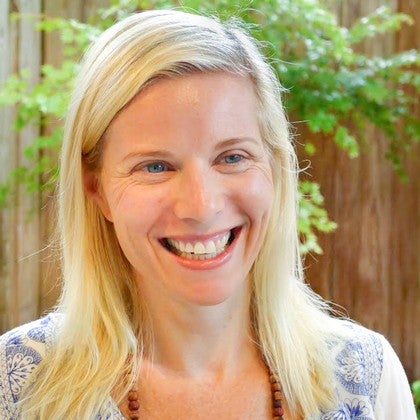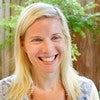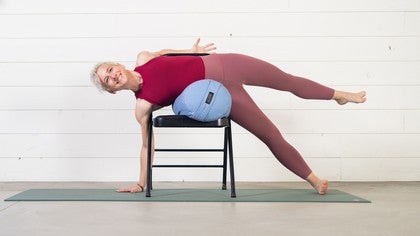
The Heart's True Nature
The first time I heard the theory I was in a beekeeping training of all places. Gunther Hauk was teaching the principles of biodynamic apiarian techniques and he dropped this bomb in a lecture: “The heart is not a pump.”
I looked around stunned, expecting to see other jaws dropping like mine, but everyone else just gazed pleasantly toward the front of the room. Granted, the other beekeepers in the training were more seasoned in the principles of Rudolph Steiner and biodynamics. Most of them were Waldorf teachers or had attended Waldorf schools. Discussing anatomy during a beekeeping lecture was in no way far-fetched for them. They were accustomed to weaving connections through multiple disciplines – art connecting to movement connecting to science connecting to sound. I, on the other hand, had received a run-of-the-mill education throughout all my years of schooling and had been taught (unbeknownst to me) to perceive the world in mostly conventional ways. I was dumbfounded; but also incredibly intrigued.
At the time, I was a few years into my second decade of practicing and teaching yoga and I had decided that this next leg of my yoga journey would be a deep dive into anatomy. I was learning muscles and bones and all the generic stuff, but this comment from Gunther about anatomy was...cosmic.
Soon thereafter, Katy Bowman’s book Move Your DNA was published. Under the subtitle Hemodynamics and Exercise, Bowman says this:
Most people know that the cardiovascular system delivers oxygen and nutrients to the body while removing waste from the tissues. They believe that this process is driven by the heart muscle, using the arterial and venous system to circulate the blood. This definition is not exactly incorrect, but it is oversimplified to the point of being misleading when used in the context of improving cardiovascular health.
Oversimplified? Bring on the complexities. Misleading? Had I been misled? No longer would I wander blindly down the established path.
I was both excited and intimidated. Of course the heart isn’t a pump, I thought. There had to be more to the heart than that unadorned description. The heart, in all its glory, deserved more acclaim. Bowman’s book, teeming with unorthodox views, made complete and utter sense to me.
Katy goes on to explain that the network of the capillary system throughout our bodies is far more incredible and expansive and ubiquitous than most diagrams are able to exemplify. We tend to think that our blood vessels are just scattered in the body, appropriately placed where they are most needed. We don’t realize that there are blood vessels everywhere inside of us. Which means our whole body is the heart, not just the bulge of muscle in our chest cavity.
As Gil Hedley once explained, the heart is the head of the octopus and the blood vessels are tentacles. What’s great about this metaphor is that it reminds us that the tentacles (our blood vessels, metaphorically) are not separate from the heart. If we want to learn more about an octopus, we wouldn’t just study its head. Same with the heart; if we want to explore the workings of the heart, we must study the organ in our ribcage and also include its seemingly-infinite “arms” in our research.
Why does this point matter? Particularly, why does this matter for us as yogis?
If Gil is encouraging us to see the heart as “a whole-body phenomenon” (his words), then we must consider the health of our whole body when we think of our cardiovascular health. How well does our blood move through our body? Are there areas that are tight and may be constricting the blood flow? And how about our thoughts? Are they encouraging our blood to flow freely or are they creating a resistance to the flow of life within our bodies?
Gil said in the first dissection I attended with him that if you refuse to flow with the rhythm of your heart, you are resisting the flow of life within you. Again, I was stunned by this – and also incredibly motivated. We have to allow the blood to do what it wants to do; and what it wants to do is move freely, without restriction.
I will never forget Gil peering into a chest cavity of a cadaver and saying, “Now that heart was a pump!” Before even handling the actual organ, Gil – with all his wisdom of witnessing hundreds upon hundreds of dissected bodies – had seen something that was indeed different from the hearts of the eleven other cadavers in the room. What he noticed was not about texture, but size. When I asked him what he was seeing, he said, “megalocardia is a key indicator that the beautiful heart center, the place in the whole heart where the blood refreshes its movement, has been reduced to a pump by the resistance of the periphery, demanding that the heart work, rather than dance.”
So why did this particular cadaver’s heart act as a pump?
The cadaver had a pain pack installed in his abdomen, pretty severe arthritis in both his knees and on one side of his lower body, the muscles of the leg had atrophied. It was quite possible that this man had experienced much less movement towards the end of his life based on these clues. By not moving, it appeared he had put a demand on his heart.
Bowman explains this in Move Your DNA when she states that, “within a sedentary culture, the heart becomes the sole mover of blood.” She adds that “this is not ‘how the body works’, but how the body operates in a movement drought.”
Blood isn’t being pumped in your body; it is being “sucked to the corners of your body” (Gil Hedley). The cardiovascular system and the musculoskeletal system are a team; they are working together to move your blood. While most of us have been given the model of a heart pushing blood around the body as the lone provider of blood flow, Bowman says that “in reality, working muscles pull your blood to tissues that need it”.
When you use a muscle or stretch a muscle or even move a muscle, you are generating more blood flow to that muscle. You are engaging the muscle in your aliveness and as that muscle perks up and comes back to life, it needs to be fed.
As Katy puts it, “our very own system of oxygen distribution depends on frequent and constantly varying muscle use.... If you don’t move, your cells don’t get fed. If cells don’t get fed, they die.”
My favorite metaphor in regards to the heart is another one of Gil’s galactic analogies. He said once that the heart is like a whirling dervish – spinning and dancing with the blood. When our blood returns to the heart weary after a long journey to the far reaches of our body, the heart – in all its pulsating aliveness – spins the blood and twirls in a dance to rejuvenate the blood. In this way, the heart is not a pump, but more like a spirited friend that we visit when you need a pep talk. Not a pump, a dance partner. Like a loving parent does with a beloved child, the heart takes the blood into its chambers and holds it and spins in a loving embrace and then sends it back out into the body renewed.
The miracle: your heart does this over and over and over and over again your entire life – often without recognition. But don’t let this be a thankless job! Pause and breathe and feel your blood moving. Then move your body and further encourage this circulating dance.
Are you following your heart? Are you living so that your blood feels free to flow with all the wildness and abandon and compassion of which your blood is capable?
Gil once said when lecturing on the cardiovascular system, “Are you being moved by the heart or insisting the heart move stuff for you?”
This question can help you live your best life. Start treating the heart as your faithful guide and become its humble and willing attendant. Move more – with less tension and more attention and purer intention.
Your heart wants to be in rhythm with the pulse of Life, which is your truest nature. Try meditating on the blood and see if it draws you inward to that deep seed of calm within you - this is your most authentic Self.
Allow your blood to flow without restriction. The cosmic sound of OM is being chanted in the movement of your blood. Can you hear it? Listen. Listen. Listen.
Comments
You need to be a subscriber to post a comment.
Please Log In or Create an Account to start your free trial.













